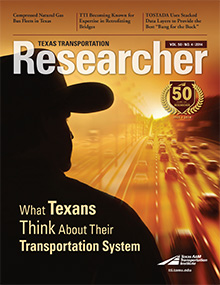If the concept of layering works for a popular Mexican food dish, why can’t the same concept work when analyzing data to prioritize roadway improvements?

That’s the thinking behind a new approach that examines a comprehensive set of condition and performance measures, and weighs those factors to help determine where transportation improvement projects make the most sense. The approach is being pioneered by researchers at the Texas A&M Transportation Institute (TTI). They’re examining congestion levels, crash frequency, pavement quality, bridge condition and freight value to create the first version of the TOol using STAcked DAta (TOSTADA).
“With limited funding and an increased emphasis on fiscal accountability and information transparency, transportation improvements need to show that they provide the best ‘bang for the buck,’” says TTI Research Fellow Tim Lomax. “The Texas Legislature, in fact, called for such an approach in approving the state budget in 2011, requiring that highway projects have the greatest possible impact on a combination of factors, including safety, pavement quality and economic benefits, in addition to addressing congestion. The TOSTADA analysis model was developed with those collective needs in mind.”
The model uses geographic information system tools to illustrate individual color-coded data maps for each of five analysis factors. Data sets for each of those factors are visually layered, providing a thorough assessment of diverse and sometimes competing needs. A roadway safety project, for example, may also provide improvements in congestion, bridge and pavement conditions, and the value of freight moved.
Ultimately, the intent is to use multiple data sources to draw insights and lead to a more thoughtful and comprehensive project comparison and selection process, as well as help to ensure more well-informed policy decisions. Too often in the past, researchers say, those decisions may have been driven by a process focused on engineering factors with less regard to economics, safety or quality-of- life considerations.
Better project comparison and selection can also enhance the public engagement process, helping to ensure that transportation system users are substantively involved in decisions on the best ways to invest increasingly limited transportation funding.
“Transportation planners can use this approach as a form of common dialogue with policy makers,” says TTI Research Scientist David Schrank. “That can help both parties illustrate investment costs and benefits more effectively, and make the case for the most appropriate improvement projects.”
The researchers note that the TOSTADA demonstrates the viability of the data-layering approach, but they also point out that more work is needed to refine the model. Future versions might involve the addition of other data sets, such as right-of-way availability, environmental impacts, demographics and benefit-cost ratios.
